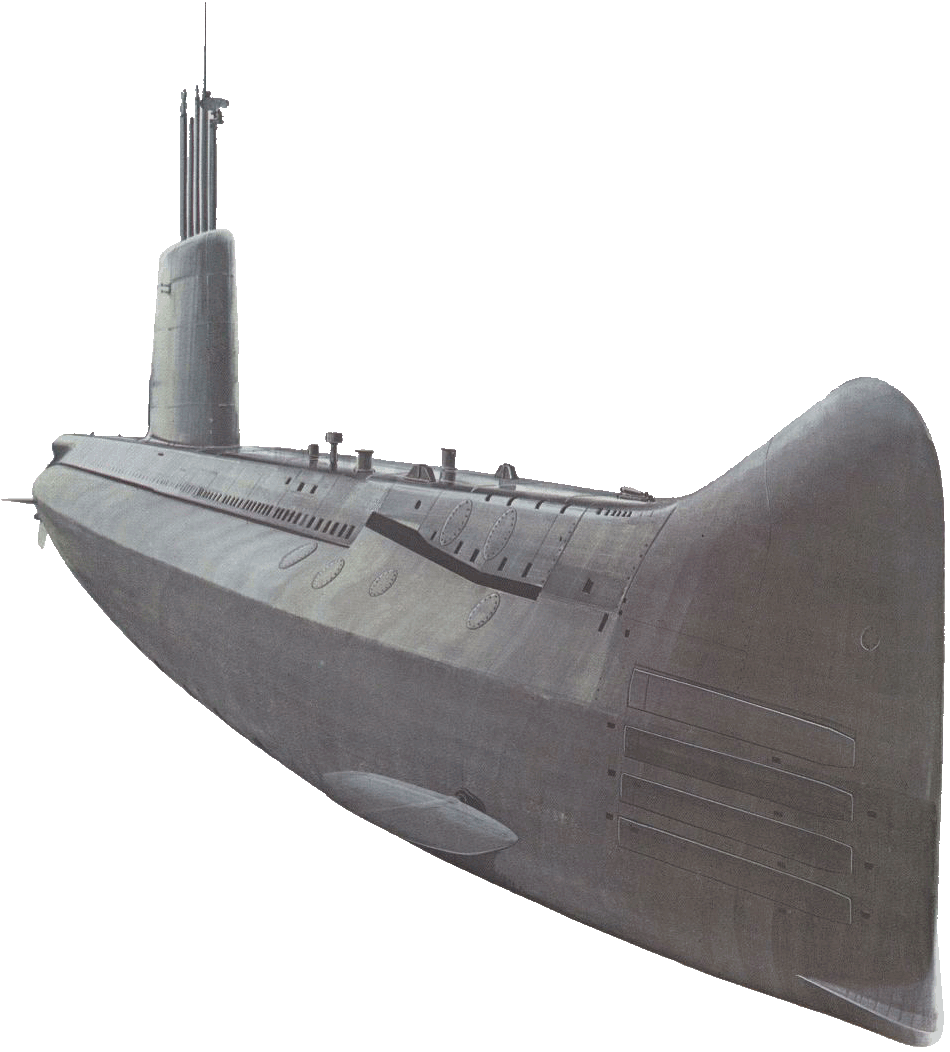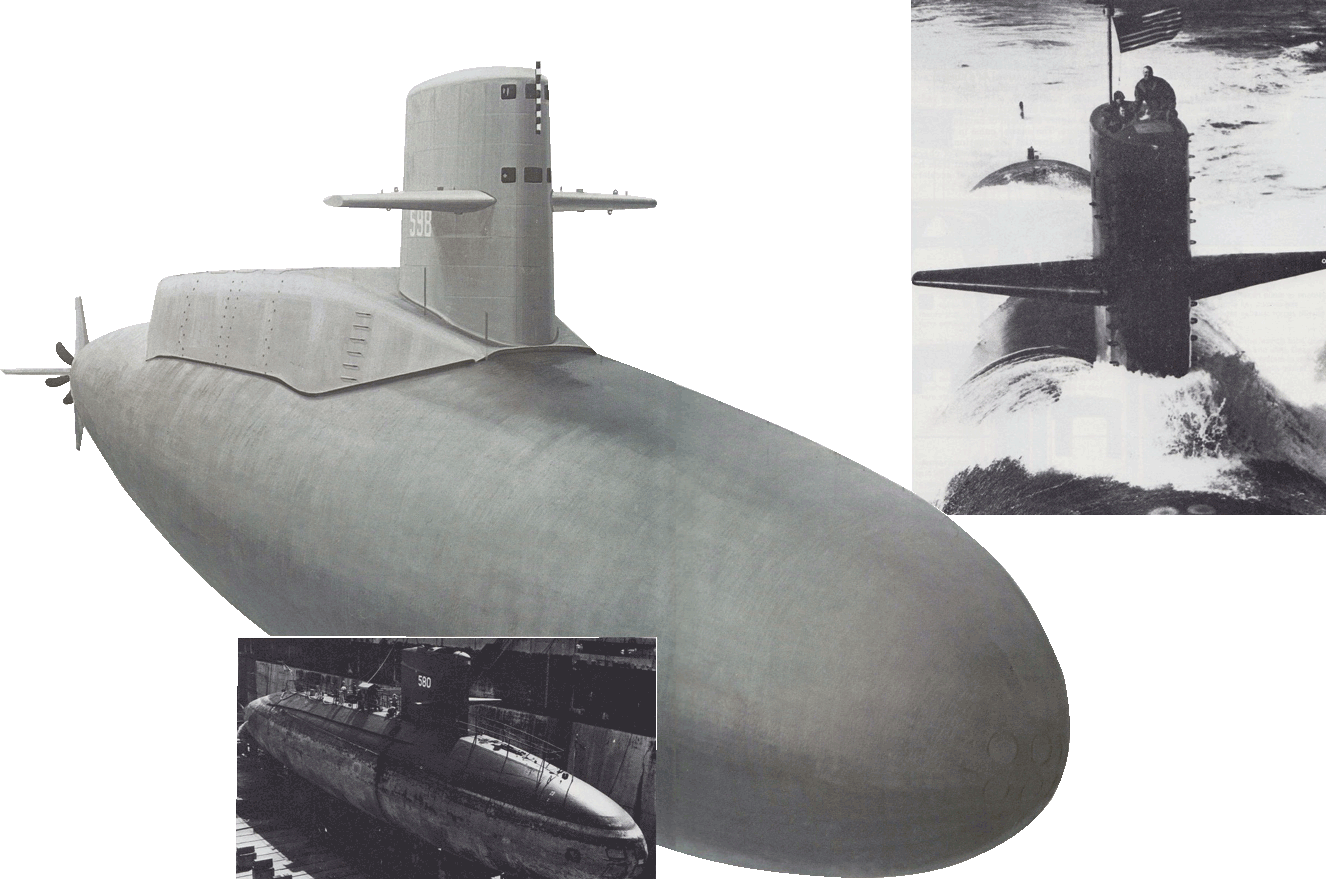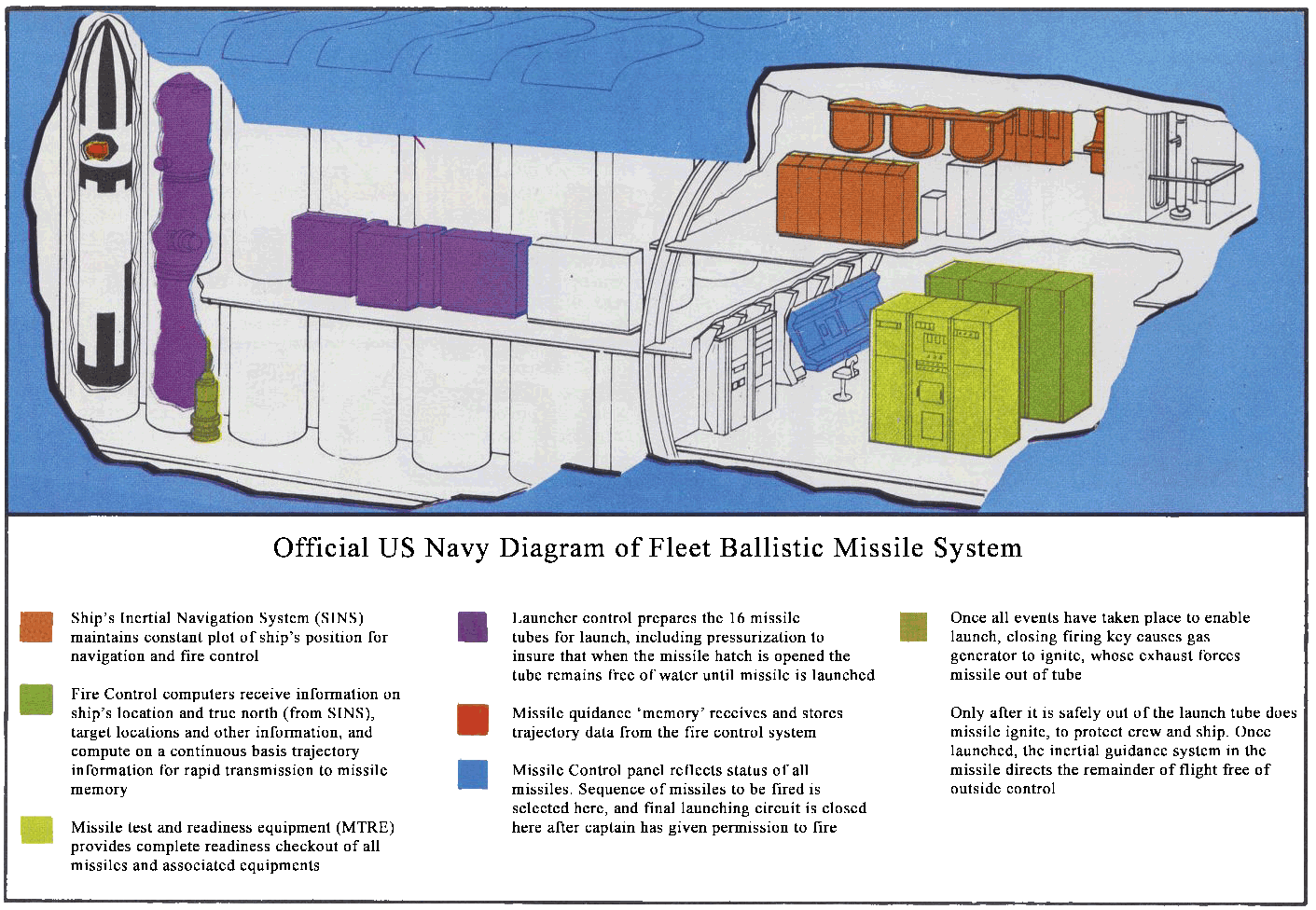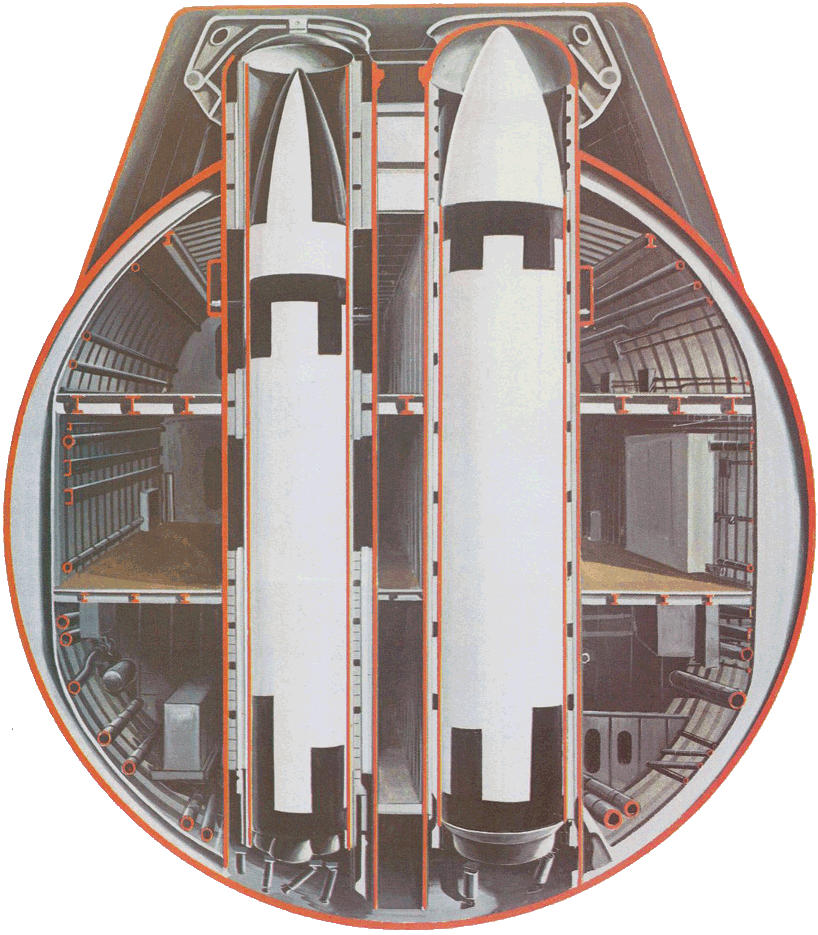
ANTONY PRESTON, JOHN BATCHELOR
THE SUBMARINE SINCE 1919
TheRoyal Navy contented itself with modernizing its "T" and "A" Class boats, during the 1950s, along the lines of the American "Guppy" programme. Unfortunately the earlier "Ts" and the "S" Class had riveted hulls, which made them unsuitable for modernisation, but several were modified for experimental work. At the same time a new class of submarines was built to incorporate the latest ideas. These were known as the Porpoise Class, and they were followed by the very similar Oberon Class, which acquired an enviable reputation for reliability and quietness. Since 1962 a total of 14 have been sold to foreign buyers, and they are regarded as the best conventional submersibles available.

Russian "Y" Class. This is the Russian version of the Polaris submarines, with sixteen vertical tubes for launching the 1,350-mile range SS-N-6 missile. The first were reported in 1968 and 32 have been built
TheFrench had to rebuild their submarine force from scratch after the war. Apart from a handful of worn-out pre-war submarine, and some borrowed from the British, they had only five incomplete hulls which were worth rebuilding. Taking advantage of a British offer of four "S" Class for training, they set to work to redesign the five Creole Class hulls which had survived the war. These came into service between 1946 and 1953, and lessons were incorporated in the six Narval Class built in 1951-5. Two more classes were designed in the 1950s, of which the later Daphne Class of 1957-67 proved as commercially successful as the British Oberons.
Holland found herself in a similar situation in 1945, with her fleet comprising worn out or borrowed submarines. In 1954 the Dolfijn, first of a unique class, was laid down. She had a triple hull, with three separate cylinders disposed in a triangle. This novel idea had the advantage of making better use of the internal space available, and also gave great strength, but it has not been repeated in any other navy.

French Daphne Class. Like the British Oberons, the Daphne Class has proved a successful export to foreign navies, despite the fact that three have been lost in accidents. The eleven boats came into service between 1964 and 1970. Displacement: 869 tons (surfaced) Armament: Twelve 21·7-in (550-mm) torpedo-tubes (8 forward, 4 aft); at least 16 torpedoes carried Speed: 12,5 knots (surfaced) 16 knots (submerged)
TheSwedish Navy had not suffered any loss, being neutral in the Second World War, but to maintain that neutrality it was necessary to keep abreast of developments. The Sjölojenet Class was streamlined and modernised, and four new classes were built. Of these the Sjöormen Class is the latest. The other Scandinavian, navies also continued the tradition of building submarines in their own yards. The exception was Finland, which had to pay a heavy price for being on the wrong side in the war, and was forbidden to possess submarines.
The other Baltic navy to get back into the submarine business was, inevitably.
Germany. In 1956 two sunken Type XXIII boats were salvaged and reconditioned for training duties as the Hai and Hecht. A third the former Type XXI U2540, was in 1960 recommissioned as the Wilhelm Bauer, and has been used for research purposes. The first indigenous design appeared in 1961, when U1 was launched at Kiel but U1 and U2 had to be rebuilt to remedy structural weakness.

Dutch Dolfijn Class. These four submarines are unique in having a hull comprising three cylinders arranged in a triangular shape. This gives greater roominess without sacrificing strength for deep diving. The upper cylinder houses the crew, navigational equipment and armament, while the lower cylinders contain the propulsion machinery. Displacement: 1,494 tons (surfaced). Armament: Eight 21-in torpedo tubes (4 forward, 4 aft); 16 torpedoes carried Speed: 14,5 knots (surfaced), 17 knots (submerged)
Meanwhile the Americans had been developing the concept of the "hunter-killer" submarine, using ultra-sensitive listening gear and improved Asdic, known as Sonar in the USN. The submarine makes a good anti-submarine weapon, primarily because she is operating in the same medium as her quarry, but perfection of the techniques had to wait for new silent-running motors and efficient tracking gear. A serious disadvantage is that she has to operate virtually "blind", without the rapid communication and readily accessible visual data available to surface ships. But the real weakness is that despite all the improvements in propulsion and streamlining, a "fast" underwater submarine is only fast for a matter of hours, and must slow down before she exhausts her batteries. Until nuclear power was a reality, this was the obstacle to further progress.
The first water-cooled reactor was ready in 1952, when the USS Nautilus was begun. It took submarine propulsion back nearly 50 years to the days of the French and British steam-powered submarines, for the only way to use the heat of a nuclear reactor is to convert water to steam. Thus the Nautilus was driven by twin-shaft geared steam turbines, which developed 13,400 shaft horsepower and drove her at approximately 20 knots underwater. Her size inevitably made her clumsier than any wartime submarine, but it had its hidden advantages; only a large hull could provide the crew comfort necessary to support the high endurance provided by nuclear propulsion. In other words, the designers had come up against an old truism in submarine design: that crew efficiency is related to size, and even if a much smaller reactor could have been produced, the crew of a smaller submarine could not cruise submerged for extended periods.

American George Washington (SSBN598). This was the West's first submarine to be armed with ballistic missiles, and was a result of President Kennedy's acceleration of the Polaris development programme. She fired two of her sixteen missiles for the first time in July 1960. To bring Polaris into service as quickly as possible, the five modified Skipjack type hulls were lengthened by 130 ft to accommodate the launching tubes. Displacement: 5,900 tons (surfaced). Armament: Sixteen Polaris intermediate range ballistic missiles; six 21-in torpedo-tubes. Speed: 20 knots (surfaced), 25-30 knots (submerged)
A rare picture of an American nuclear submarine in dry dock - the Barbel (SS580)
The USS Ray (SSN653) shown here is an attack submarine of the Sturgeon Class, the largest group of nuclear submarines built to one design. They are intended to seek out and destroy other submarines and have their four torpedo-tubes amidships, to leave the bow position clear for a large sonar
The size of the Nautilus, about 3,500 tons on the surface, and a three-decked hull over 300 ft long, allowed her 100 crew members a standard of accommodation which was better in some ways than surface ships of the same size. And they needed it, for in 1955, when Nautilus was completed, she made a run from New London to Puerto Rico fully submerged. This feat was eclipsed by her submerged crossing of the North Pole on 3 August 1958, when she proved to the world that a new era of submarine warfare had begun. Between 1955 and 1957 she steamed 62,562 miles on the original core of uranium, then logged 91,324 miles on her second core, and about 150,000 miles on the third.
In 1957 a second nuclear submarine was completed, the USS Seawolf. Slightly larger than the Nautilus, she was built to test another type of reactor using liquid sodium as a coolant in place of pressurised water. Although not as successful as the other prototype, she provided valuable experience for the first "production models", the four Skate Class, which were completed in 1957-59. Their success convinced the US Navy that all future submarines should be nuclear-powered, and that decision marked a personal triumph for Admiral Hyman Rickover, who has been aptly named the "Father of the Nuclear Submarine".
In 1952 an experimental submarine had been ordered as a "Hydro-dynamic test vehicle". As the USS Albacore she entered service at the end of 1953. She revolutionised submarine design, because her "teardrop" hull form gave more speed and manoeuvrability than any submarine had ever had. Her whale-shaped hull had no deck-casing, and the "sail" was reduced to a thin dorsal fin. Since first commissioning, the Albacore has tested a variety of advanced equipment, but her main features have become the standard for later submarines; in particular the circular hull- sections and the single propeller shaft are a repetition of the British "R" Class of 1918.

Oficcial US Navy Diagram of Fleet Ballistic Missile System
The next development of the nuclear submarine was a revival of a German project to launch a V2 ballistic missile from a pod towed by a submarine. Being a liquid- fuelled rocket, the V2 was ill-suited for use at sea, but postwar progress with solid fuels led to the Polaris missile system. This is a submarine-launched intermediate range ballistic missile (IRBM) capable of being fired from below the surface of the sea. It offers three main advantages over the big land- based inter-continental ballistic missiles (ICBM):
1 By moving the launching point out to sea the likelihood of a preemptive attack by enemy ICBMs is reduced.
2 Since the furthest point on land is only about 1,700 miles from the sea, the Polaris missile needs much less fuel than ICBMs, and can be smaller.
3 The difficulty of finding submarines in the oceans of the world means that in the foreseeable future there is no counter-measure.
Polaris works on a very simple principle of physics, the fact that water is incom pressible; a missile is ejected from the submarine by gas or steam, its rocket motor ignites as it leaves the water, and the resulting downblast uses the "hard" water underneath as a launching pad.

Polaris/Poseidon Installation. This section through a US nuclear submarine shows the installation of an A-3 Polaris on the left, and its successor Poseidon on the right. They would never be installed together
One major problem had to be solved before the Polaris system could be made to work, that of navigation. As a nuclear submarine dare not surface frequently to check her position by star-sights or radio- fixes, prolonged submarine voyages demand a much higher standard of navigation than ever before. The answer came in the SINS, the Ship's Inertial Navigation System, basically a computerised method of checking the vessel's actual movement from her point of departure by means of accelerometers and gyroscopes. With SINS to track all drift and movement a nuclear submarine can dispense with magnetic compasses and dead reckoning errors, which makes a journey under the North Polar ice cap feasible. Furthermore, since a Polaris missile needs to know the distance to its target, it can be updated constantly by a fire control computer adjusting the firing trajectory from data provided by SINS.

American Skipjack. In 1959 the Skipjack introduced the revolutionary "teardrop" hull which gave much greater speed and manoeuvrability than the older type of hull. The rounded casing is reminiscent of a whale, and makes for bad handling on the surface, but once submerged the submarine performs far better
Another problem created by Polaris and nuclear propulsion was habitability. If maximum benefit was to be gained from a submarine with virtually unlimited endurance, the human element had to be catered for. Intensive research into ventilation systems showed that it might be possible to extend a submarine's submerged endurance to three months or more by recycling the air - in other words, making the crew breathe their own air after it had been refreshed with oxygen and "scrubbed" to remove toxic gases. Many interesting points came to light, particularly the need to have paints which did not give off toxic vapours, but now nuclear submarines are limited only by the endurance of their crews. This gives the submarine the same advantage that used to be enjoyed by the sailing ship - independence of bases as long as the food and water last.
The accumulation of waste causes severe problems as a hundred men will account for a large amount of potato peelings: the latest submarines are big, but they do not have unlimited space, and it is not always safe to jettison rubbish. For the same reason modern submarines have self-contained sewage systems which are pumped out when they return to base; this is also necessary because the pressure at great depths makes flushing the "head" too difficult. Because of the extended cruise period, colours of furniture and furnishings have to be brighter and more harmonious than they were, especially as they are always seen by artificial light.

Russian Leninskii Komsomol. In 1963 the Russians reported that this submarine had crossed under the North Polar ice cap. She is one of the "N" Class, the first Soviet nuclear fleet submarines to enter service. The small conning tower set far forward is a feature of this class and of the improved "V" Class. Displacement: 3,500 tons (surfaced). Armament: Six 21-in; four 16-in torpedo-tubes. Speed: 20 knots (surfaced), 25 knots (submerged)
Fortunately their great size allows nuclear submarines to have three decks, and so the accommodation can be made spacious. Crew comfort helps to reduce the strain of long patrols, but it is also necessary to provide films and gymnastic apparatus to combat boredom and the lack of exercise.
As soon as the United States Government knew that the A-1 Polaris missile was work able, permission was given to build the first of a fleet of 41 submarines, each capable of launching 16 Polaris missiles. As each missile's H-Bomb warhead was equal in power to all the high-explosive bombs dropped in the Second World War, the deterrent effect of such a system was obvious. Before the end of 1957 two newly ordered attack submarines had been redesignated Polaris submarines. A further three followed in 1958, and the five became the George Washington Class, the first Fleet Ballistic Missile (FBM) submarines
Nuclear Propulsion Power Plant

This diagram shows the basic components of the propulsion system of a nuclear submarine in the world. To mark their importance, both in size and purpose, they were also the first USN submarines to be named after people rather than reptiles or fishes.
The next class, the five Ethan Allen Class, differed principally in being properly designed for their task, rather than hurriedly adapted from a smaller type. They and the 31 Lafayette Class which followed from 1960 onwards were better arranged internally than the original George Washingtons, and had improvements such as quieter machinery, but they retain the basic layout of two rows of eight missile tubes abaft the "sail".
We have much more interesting information on this site.
Click MENU to check it out!
∎ cartalana.com© 2009-2025 ∎ mailto: cartalana@cartalana.com